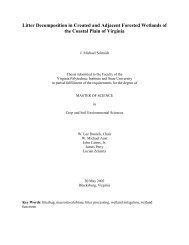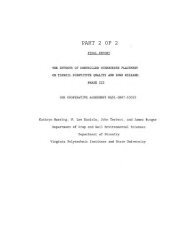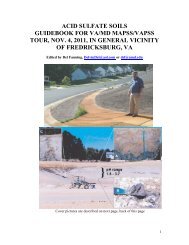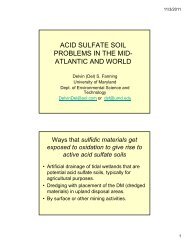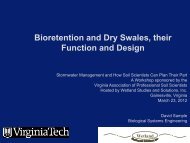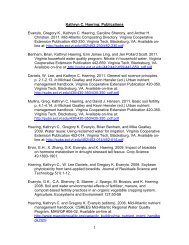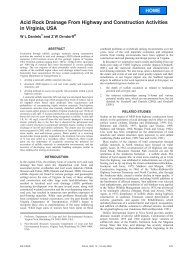Remediation of PAH-Contaminated Soils and Sediments: A ...
Remediation of PAH-Contaminated Soils and Sediments: A ...
Remediation of PAH-Contaminated Soils and Sediments: A ...
Create successful ePaper yourself
Turn your PDF publications into a flip-book with our unique Google optimized e-Paper software.
Bioavailability Analytical Methods<br />
Sites contaminated with <strong>PAH</strong>s can be evaluated using several different<br />
measurements: total extraction, mild organic extraction to assess desorbable<br />
fractions, <strong>and</strong> bioassays (assessments <strong>of</strong> bioavailability by uptake <strong>and</strong>/or toxicity<br />
to microorganisms). Although there are a range <strong>of</strong> bioassays available to assess<br />
<strong>PAH</strong> availability, they are time-consuming <strong>and</strong> can be expensive. An alternative<br />
is to use rapid, reproducible chemical tests to assess bioavailability.<br />
Although total extractable <strong>PAH</strong> levels are routinely used to assess <strong>of</strong><br />
contaminated sites, they will grossly overestimate bioavailable <strong>PAH</strong>s, <strong>and</strong> thus<br />
cannot be used to assess or predict the fraction <strong>of</strong> <strong>PAH</strong>s that is accessible to<br />
biota (Alex<strong>and</strong>er, 2000; Semple et al., 2003). Different researchers have<br />
proposed several mild organic/aqueous extraction procedures to assess the<br />
readily available <strong>PAH</strong> fraction in soil <strong>and</strong> sediments. Some <strong>of</strong> these extraction<br />
procedures include:<br />
� Extraction with n-butanol: Kelsey et al. (1997) reported that availability <strong>of</strong><br />
phenanthrene to bacteria <strong>and</strong> earthworms could be accurately predicted<br />
with n-butanol extraction. Liste <strong>and</strong> Alex<strong>and</strong>er (2002) also found good<br />
correlation between butanol extraction <strong>and</strong> <strong>PAH</strong> availability to earthworms.<br />
Bogan <strong>and</strong> Sullivan (2003) found that the n-butanol extractability <strong>of</strong> 13<br />
<strong>PAH</strong> compounds was dependent on soil organic matter content.<br />
� Triton X-100 shake: Cuypers (2001) found extraction with Triton X-100<br />
overpredicted <strong>PAH</strong> availability.<br />
� Solid phase extraction with Tenax beads: In this method, Tenax A (a<br />
porous polymer <strong>of</strong> 2,6-diphenyl-p-phenylene-oxide) removes the rapidly<br />
desorbing fraction that is equivalent to bioavailable <strong>PAH</strong> (Uyttebroek et al.,<br />
2007). Cuypers (2001) found extraction with Tenax A to correlate well with<br />
bioavailable <strong>PAH</strong>.<br />
� Aqueous β cyclodextrin shake: Reid et al. (2000b) proposed β<br />
cyclodextrin aqueous solution extraction to predict availability, <strong>and</strong> found<br />
that this solution predicted the amount <strong>of</strong> phenanthrene available to<br />
bacteria. Both Cuypers (2001) <strong>and</strong> Allan et al. (2006) found extraction with<br />
β Cyclodextrin to correlate well with bioavailable <strong>PAH</strong>s. Papadopolous et<br />
al. (2007) compared aqueous cyclodextrin extraction to mineralization <strong>of</strong><br />
phenanthrene in 4 different soils with different organic matter content<br />
ranging from 4.8 to 27 %. High correlation was found between cyclodextrin<br />
extractability <strong>and</strong> microbial mineralization <strong>of</strong> phenanthrene by indigenous<br />
bacteria.<br />
However, no one chemical test predicts the availability <strong>of</strong> all <strong>PAH</strong> contaminants<br />
to different organisms in all soils. Thus, these tests are better used along with<br />
bioassays to assess <strong>PAH</strong> bioavailability in soils (Stokes et al., 2006).<br />
84



